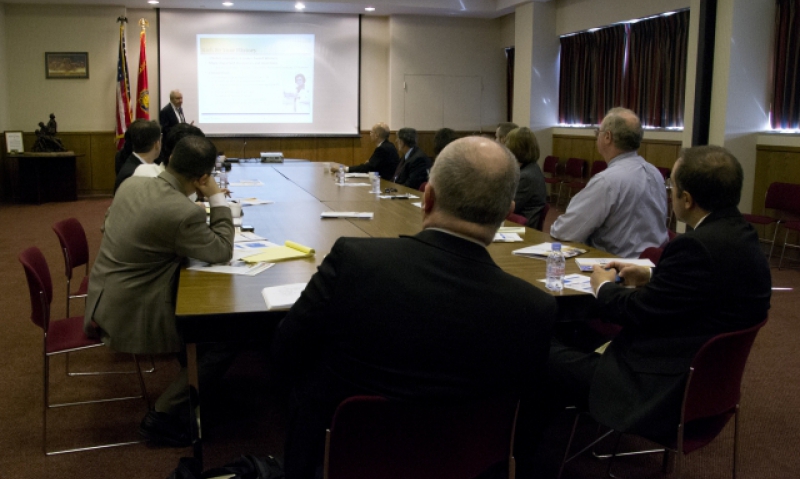
Research and development highlights include eHealth initiative, Million Veteran Program and Quality Enhancement Research Initiative.
Three officials from the Department of Veterans Affairs gave a briefing to staff members of The American Legion’s Veterans Affairs & Rehabilitation Division in Washington on June 15, explaining current initiatives in the Veterans Health Administration’s research and development (R&D) programs.
Legion staffers heard from Dr. Joel Kupersmith, chief research and development officer; Dr. David Atkins, director of eHealth’s Quality Enhancement Research Initiative (QUERI); and Dr. Robert Jaeger, scientific program manager for the Office of Rehabilitative Research and Development.
Kupersmith led off by thanking the Legion for its support of R&D funding in the VA budget, through its congressional testimony and lobbying efforts on Capitol Hill. He then discussed several R&D highlights of 2011-2012, including VA’s study of the drug risperidone, which was found to be ineffective in treating symptoms of post-traumatic stress disorder (PTSD). Progress is also being made in developing next-generation prostheses for the upper arm and ankle, and the feasibility of brain-computer interface in controlling movements of robotic arms.
The Million Veteran Project has been launched, Kupersmith said, with the goal of collecting DNA samples from 1 million veterans over the next five to seven years, in order to create a genomic database. Last October, letters were sent to veterans at 40 VA medical centers, inviting them to participate in the study and provide blood samples to be stored in a new bio-repository at VA’s medical center in Boston. For privacy protection, blood samples will be identified by bar-coded numbers instead of names.
Of the veterans contacted to participate in the project, 122,577 had opted in by June 11, while 83,587 declined; participants also have the option to receive a health assessment. Kupersmith said the resulting database will be used to "see how genes affect the body, and change it to cause disease." From this type of study, treatments can be developed to defeat certain illnesses or genetic predispositions. Such studies, Kupersmith said, have already yielded effective treatments for several cancers, schizophrenia and Alzheimer’s disease.
More research is being conducted on long-term brain damage (chronic traumatic encephalopathy) caused by IED-blast concussions, other deployment-related health issues from the Iraq and Afghanistan wars, and long-term PTSD suffered by veterans from the Vietnam War and more recent wartime eras.
PTSD treatments continue to be a key focus of R&D efforts. In 2007, VA completed the first successful trial of prolonged exposure (PE) therapy for PTSD; to date, it remains the only evidence-based treatment for the disorder. PE encourages patients to re-experience their traumatic events through remembering and engaging with, instead of avoiding, reminders of the trauma. Research is under way for the delivery of PE via telemedicine and through group sessions.
Three trial studies are set to begin this year on how well meditation works as a treatment for PTSD. Two studies will focus on mindfulness-based stress reduction and the third will involve mantram repetition. Research is being conducted on other alternative or complementary medical treatments, including music therapy, acupuncture for insomnia and bright light therapy.
Atkins gave an update on eHealth’s QUERI, established in 1998 to speed-up the adoption of effective practices throughout VA. He also discussed the "Myhealthevet" (MHV)feature on VA’s website, which offers veterans an online resource for secure messaging to their doctors, nurses and other clinicians. More mobile health applications, such as VA’s PTSD Coach, are being developed to enhance the delivery of health care via the Internet. Another online tool that is now available at the MHV webpage is Blue Button, (http://www.va.gov/bluebutton/) which allows veterans to download their VA health data in a variety of simple formats. Atkins said that Blue Button makes it easier for veterans to share their medical records with non-VA health-care providers.
Jaeger’s presentation covered recent developments in prosthetics: the DEKA Gen2 Arm (controlled by shoe-mounted sensors), the Electronic Ankle-Foot Prosthesis, and Wayfinding, which helps the mobility of visually impaired veterans through a combination of computer vision, GPS, digital compass and web-based maps. He concluded his briefing with a video that showed the BrainGate Pilot Clinical Trial, which took place on April 12, 2011, in Dorcester, Mass. In the video, a paralyzed woman uses her thoughts to control a robotic arm and succeeds in drinking from a bottle held in the arm’s hand.
The project, which breaks new ground in the field of prosthetics, is a joint collaboration between VA, DoD, Harvard and Brown universities, and Massachusetts General Hospital. A wireless version of BrainGate is being worked on, Jaeger said, and thought-control of robotic arms may be a common practice in about 10 years.
- Veterans Healthcare

